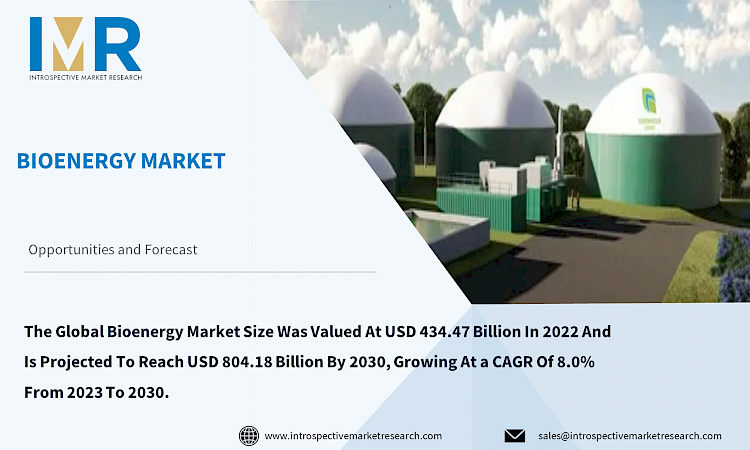
The Global Bioenergy Market Size Was Valued At USD 434.47 Billion In 2022 And Is Projected To Reach USD 804.18 Billion By 2030, Growing At a CAGR Of 8.0% From 2023 To 2030.
Bioenergy is one of many different resources available to help meet energy demand. It is a type of renewable energy derived from recently living organic materials known as biomass, and it can be used to generate transportation fuels, heat, electricity, and products. Agriculture and forest residues, energy crops, and algae are all examples of biomass. Energy Department and National Laboratories scientists and engineers are developing new, more efficient methods of converting biomass into biofuels that can replace conventional fuels such as gasoline, diesel, and jet fuel. Fuel lamps in the 1820s used a mixture of camphene and alcohol. In the United States, the sale of biofuel used in lamps reached 100 million gallons per year. In addition, the first internal combustion engine was patented in the United States. Karl Benz patented the engine in 1886, and it ran on a mixture of ethanol and turpentine.
Top Key Players in Bioenergy Market:
Enexor Energy (US), Drax Group (US), Lignetics (US), Pacific Bioenergy Corp (Canada), Green Plains Inc. (US), Enviva (US), Enerkem (Canada), ADM (US), POET (US), Ameresco, Inc. (US), and Other Major Players.
Market Dynamics and Factors for Bioenergy Market:
Drivers:
Rising Demand for Renewable Energy
The demand for renewable energy has increased in the world due to, rising investment in renewable energy, increasing technological advancement in producing and storing renewable energy as well as economic and industrial growth of developing countries. Bioenergy is a renewable energy source. As the global dynamics of renewable energy change, there is a greater shift from fossil fuels to renewable energy as more countries capitalize on the benefits and energy potential of renewables, and both developing and developed countries invest more in renewable energy. The economics of renewables are improving as investments in renewable energy increase. Thus, supporting the growth of the bioenergy market in the forecast period.
Opportunities:
Implementation of Favourable Government Regulations and Guidelines
Governments are driving bioenergy as a means to achieve a sustainable economy by developing incremental regulations and more instrumental policies concurrently. The Dutch central government, for example, supports the development of new technologies for generating biomass energy through the SDE grant scheme. The SDE provides subsidies for the use of renewable energy generation techniques and other CO2-reducing techniques. The table below summarizes the techniques that may be eligible for SDE funding in 2021. Thus, the future holds a lucrative opportunity for all the market players involved in the production of bioenergy.
Segmentation Analysis of the Bioenergy Market:
- By type, the solid biomass segment is forecasted to dominate the bioenergy market in the upcoming future. Solid biomass is a renewable energy source derived from the combustion of animal and plant waste. Almost every industry produces waste that can be converted to heat and electricity, including agriculture, forestry, colleges, universities, municipalities, hotels, resorts, sports venues, hospitals, and correctional facilities.
- By applications, the heat generation segment is expected to have the highest share of the bioenergy market in the projected timeframe. Biofuels are primarily used to generate heat. Heat is also generated by biomass and biowaste. Biomass heat is commonly used in buildings.
Regional Analysis of the Bioenergy Market:
The Europe region is anticipated to have the highest share of the bioenergy market in the forecast period due to an increase in investments and R&D toward bioenergy, the Presence of key players, and a huge consumer base in the region. France, Germany, Italy, and Sweden are the EU's top bioenergy consumers in terms of gross inland consumption, considering both domestic production and bioenergy carrier imports. In contrast, the Scandinavian and Baltic countries, as well as Austria, have the highest per capita consumption of bioenergy. Germany's biofuel production reached around 146 petajoules that year, placing the country among the top five countries in biofuel production, and the leading producer in Europe. Wood is the most important renewable energy source in many EU Member States.
Key Industry Development:
- In August 2021, EnviTec Biogas AG started the operations for its biogas project in China, following a construction period of just 12 months. Input for the 1,570 Nm? biogas plant located in Shanxi province would include maize stover silage, turkey litter, and dairy cattle manure.
- In July 2021, EnviTec Biogas AG signed an agreement with Liquid 24/7 GmbH to transport & distribute bio-LNG produced by EnviTec Biogas AG at Gustrow to heavy-duty customers at its truck fueling stations in Germany.





